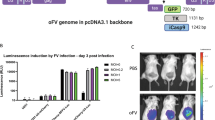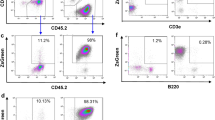Abstract
Although xenotransplantation of retrovirus-producing cells into a tumor has been shown to be effective for the treatment of cancer, injections of recombinant retroviruses are much more feasible for clinical applications. We established a clone producing retroviruses carrying the herpes simplex virus thymidine kinase (HSVtk) gene with titers of up to 4 × 107 colony-forming units/ml, and examined the effectiveness of in vivo gene therapy against cancer. Syngeneic mice were inoculated subcutaneously with murine hepatocellular carcinoma (HCC) cells, BNL1ME A.7R.1, and the treatment was initiated after tumors were established. When mice were given an intratumoral injection of HSVtk-carrying retroviruses or their producing cells followed by ganciclovir (GCV) treatment, significantly pro- longed survival periods were observed. When mice were treated with repeated intratumoral injections of HSVtk-carrying retrovirus-producing cells, significant antitumor responses and some cures were induced by GCV treatment. Furthermore, repeated intratumoral injections of HSVtk-carrying retroviruses and GCV treatment resulted in complete regression of established HCC tumors in all animals used in the experiment. Mice that completely eradicated tumors exhibited protective immunity against wild-type HCC tumors. These results suggest that repeated injections of HSVtk-carrying retroviruses followed by GCV treatment is a potent modality for the treatment of solid tumors.
This is a preview of subscription content, access via your institution
Access options
Subscribe to this journal
Receive 12 print issues and online access
$259.00 per year
only $21.58 per issue
Buy this article
- Purchase on Springer Link
- Instant access to full article PDF
Prices may be subject to local taxes which are calculated during checkout








Similar content being viewed by others
References
Wanebo HJ, Falkson G, Order SE . Cancer of the hepatobiliary system In: DeVita V, Hellman S, Rosenberg SA (eds) . Cancer: Principles and Practice of Oncology 3rd edn: Lippincott: Philadelphia 1989 pp 836–874
Kew MC . Clinical, pathologic, and etiologic heterogeneity in hepatocellular carcinoma: evidence from Southern Africa Hepatology 1981 1: 366–369
Brotodihardjo AE et al. Hepatocellular carcinoma in western Sydney: aetiology, changes in incidence, and opportunities for better outcomes Med J Aust 1994 161: 433–435
Venook AP . Treatment of hepatocellular carcinoma: too many options? J Clin Oncol 1994 12: 1323–1334
Colleoni M et al. Medical treatment of hepatocellular carcinoma: any progress? Tumori 1994 80: 315–326
Mullen CA . Metabolic suicide genes in gene therapy Pharmac Ther 1994 63: 199–207
Field AK et al. 9-{[2-Hydroxy-1-(hydroxymethyl) ethoxy]methyl}guanine: a selective inhibitor of herpes group virus replication Proc Natl Acad Sci USA 1983 80: 4139–4143
Crystal RG . Transfer of genes to humans: early lessons and obstacles to success Science 1995 270: 404–410
Yang Y et al. Cellular immunity to viral antigens limits E1-deleted adenoviruses for gene therapy Proc Natl Acad Sci USA 1994 91: 4407–4411
Kaplan JM, Smith AE . Transient immunosuppression with deoxyspergualin improves longevity of transgene expression and ability to readminister adenoviral vector to the mouse lung Hum Gene Ther 1997 8: 1095–1104
Bramson JL, Hitt M, Gauldie J, Graham FL . Pre-existing immunity to adenovirus does not prevent tumor regression following intratumoral administration of a vector expressing IL-12 but inhibits virus dissemination Gene Therapy 1997 4: 1069–1076
Ross G et al. Gene therapy in the United States: a 5-year status report Hum Gene Ther 1996 7: 1781–1790
Patijn GA et al. High-efficiency retrovirus-mediated gene transfer into the livers of mice Hum Gene Ther 1998 9: 1449–1456
Kuriyama S et al. A potential approach for gene therapy targeting hepatoma using a liver-specific promoter on a retroviral vector Cell Struct Funct 1991 16: 503–510
Cao G et al. Construction of retroviral vectors to induce strong hepatoma cell-specific expression of cytokine genes J Gastroenterol Hepatol 1996 11: 1053–1061
Cao G et al. Complete regression of established murine hepatocellular carcinoma by in vivo tumor necrosis factor α gene transfer Gastroenterology 1997 112: 501–510
Kuriyama S et al. Tissue-specific expression of HSV-tk gene can induce efficient antitumor effect and protective immunity to wild-type hepatocellular carcinoma Int J Cancer 1997 71: 470–475
Kuriyama S et al. Bystander effect caused by suicide gene expression indicates the feasibility of gene therapy for hepatocellular carcinoma Hepatology 1995 22: 1838–1846
Tamura M et al. Targeted killing of migrating glioma cells by injection of HTK-modified glioma cells Hum Gene Ther 1997 8: 381–391
Short MP et al. Gene delivery to glioma cells in rat brain by grafting of a retrovirus packaging cell line J Neurosci Res 1990 27: 427–439
Ram Z et al. In situ retrovirus-mediated gene transfer for the treatment of brain tumors in rats Cancer Res 1993 53: 83–88
Culver KW et al. In vivo gene transfer with retroviral vector-producer cells for treatment of experimental brain tumors Science 1992 256: 1550–1552
Bowles NE et al. A simple and efficient method for the concentration and purification of recombinant retrovirus for increased hepatocyte transduction in vivo Hum Gene Ther 1996 7: 1735–1742
Smiley WR et al. Establishment of parameters for optimal transduction efficiency and antitumor effects with purified high-titer HSV-TK retroviral vector in established solid tumors Hum Gene Ther 1997 8: 965–977
Yoshimatsu T, Tamura M, Kuriyama S, Ikenaka K . Improvement of retroviral packaging cell lines by introducing the polyomavirus early region Hum Gene Ther 1998 9: 161–172
Vile RG et al. Systemic gene therapy of murine melanoma using tissue specific expression of the HSVtk gene involves an immune component Cancer Res 1994 54: 6228–6234
Miller DG, Adam MA, Miller AD . Gene transfer by retrovirus vectors occurs only in cells that are actively replicating at the time of infection Mol Cell Biol 1990 10: 4239–4242
Patek PQ, Collins JL, Cohn M . Transformed cell lines susceptible or resistant to in vivo surveillance against tumorigenesis Nature 1978 276: 510–511
Miller AD, Buttimore C . Redesign of retrovirus packaging cell lines to avoid recombination leading to helper virus production Mol Cell Biol 1986 6: 2895–2902
Tsuruo T et al. Metastasis after intravenous inoculation of highly metastatic variants of mouse tumors and the effects of several antitumor drugs on the tumors Gann 1984 75: 193–198
Kuriyama S et al. Gene therapy for the treatment of hepatoma by retroviral-mediated gene transfer of the herpes simplex virus thymidine kinase Int Hepatol Commun 1993 1: 253–259
Author information
Authors and Affiliations
Rights and permissions
About this article
Cite this article
Kuriyama, S., Masui, K., Kikukawa, M. et al. Complete cure of established murine hepatocellular carcinoma is achievable by repeated injections of retroviruses carrying the herpes simplex virus thymidine kinase gene. Gene Ther 6, 525–533 (1999). https://doi.org/10.1038/sj.gt.3300869
Received:
Accepted:
Published:
Issue Date:
DOI: https://doi.org/10.1038/sj.gt.3300869
Keywords
This article is cited by
-
The inflammatory cytokine TNFα cooperates with Ras in elevating metastasis and turns WT-Ras to a tumor-promoting entity in MCF-7 cells
BMC Cancer (2014)
-
Gene Therapy Strategies for Hepatocellular Carcinoma
Journal of Biomedical Science (2006)
-
Gene therapy of hepatocarcinoma: a long way from the concept to the therapeutical impact
Cancer Gene Therapy (2003)
-
Antitumor effects on human melanoma xenografts of an amplicon vector transducing the herpes thymidine kinase gene followed by ganciclovir
Cancer Gene Therapy (2002)
-
Hydroxyapatite ceramics as a carrier of gene-transduced bone marrow cells
Journal of Orthopaedic Science (2002)



